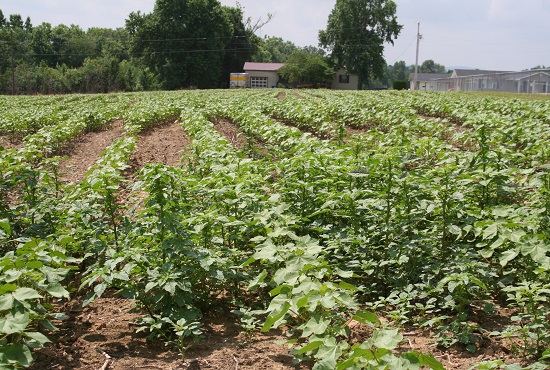The Mill Market Forces Grower Adjustments As U.S. Cotton Sets Sail
While it may be an innate patriot characteristic for U.S. growers to want their cotton to be consumed by domestic mills, it’s not realistic. For U.S. cotton growers this year, there is a 75% chance that the fiber from their farms will take a long ride on a slow boat to China. That being said, growers’ attention needs to turn toward what they can do to make sure their fiber’s quality will meet the international mill specifications to qualify it for the trip.
Based on the latest USDA data (with almost all the 2006 U.S. crop classed), U.S. growers have outdone themselves again, banking the third highest yielding crop on record. “That is very impressive, especially considering the number of acres that were abandoned compared to the two previous years,” explains Vikki Martin, associate director, Quality Research for Cotton Incorporated.
From a “big-picture” perspective, the quality of the 2006 crop is similar to the 2005 crop, but if you dig deeper, regional changes offer a different picture. “One example of that change is illustrated by longer fiber length coming out of West Texas,” adds Martin.
Providing What They Want
International mills have the option of buying a wide range of cottons from many different countries. “Based on conversations with merchants and visits we’ve made with some of those international customers, especially those in Asia, we are finding these mills tend to request and purchase a higher level of cotton quality than what [U.S.] mills traditionally requested,” says Martin.
That higher quality is needed to accommodate a different spinning system. Ring spinning continues to be the dominant textile spinning system among the world’s mills. “In China alone, there are an estimated 70 million ring spindles,” explains David Clapp, director, Fiber Processing, Cotton Incorporated. “To efficiently produce yarn on a ring frame, the length of cotton’s fiber is paramount, with fineness and strength following in importance.”
In addition to an increase in their base quality requirements, short fiber content, contamination and neps are closely monitored by international mills. “The U.S. continues to hold a high reputation when it comes to low contamination in our cottons and we need to continue to be diligent in our efforts to maintain that excellent reputation,” adds Clapp.
If we look at the percentage of the U.S. crop that would meet those international expectations, it is easy to see we have made gains in some areas but lost valuable ground in others (see chart).
| Percentage of U.S. Crop That Meets International Quality | |||
| 2004 Crop | 2005 Crop | 2006 Crop | |
| Staple Length (35 or better) | 64.4% | 59.6% | 68.9% |
| Micronaire (3.5-4.9) | 83.8% | 82.0% | 79.8% |
| Color Grade (31 or better) | 43.6% | 71.0% | 59.4% |
| LUI (82 or better) | 41.0% | 17.2% | 29.9% |
From a 9.3% gain in staple length and a 0.2% drop in micronaire from 2005 to 2006, to an 11.6% loss in color grade, but a 12.7% gain in length uniformity index (LUI), the numbers tell the tale.
“If all parameters are included in the overview, it’s easy to see how much U.S. cotton would be excluded from that increase vs. what base quality U.S. mills requested,” adds Martin. Very few mills actually specify LUI characteristics when purchasing cottons, but it is an important parameter to consider.
“Length Uniformity Index is going to be a concern to spinners because it is somewhat related to potential short fiber content,” reminds Martin. A lower LUI (under 80) can reduce a mill’s ability to spin finer counts, can increase yarn unevenness and total imperfections and can increase the loss of short fibers during the carding and/or combing process. “LUI is currently the best high-speed measurement of short fiber index that we have, but it is not an exact measurement of short fiber content on a bale-by-bale basis,” concludes Martin.
Next Stop, China
Through Cotton Incorporated’s “Fellows” (CIF) Program and other cooperating research with land grant university breeders, there are extensive research efforts in the works to enhance the quality potential of tomorrow’s cotton varieties.
“Our breeders are paying great attention to information gained by testing their samples through the Advanced Fiber Information System (AFIS),” explains Dr. Don Jones, associate director, Agricultural Research for Cotton Incorporated. Despite the fact that AFIS is slow to run, statistical information gained through AFIS, especially information from breeder sample tests, provides length distribution information — which is just as important as fiber length — in terms of cotton’s ability to be processed efficiently.
A general direction of improving the potential quality characteristics of future varieties has been established through these types of research and development programs. But growers realize that the discipline of breeding is a long-term process with gains offered incrementally over time.
In 2006, seven new lines of cotton germplasm were released thanks to Cotton Incorporated-funded research projects with the University of Arkansas. These germplasm lines can be used to develop varieties to help improve fiber quality and yield potential. The release of these lines is a direct result of Cotton Incorporated’s Breeding and Genetics Initiative, and stems from a multi-year field testing project in which the germplasm was studied under a wide range of environmental factors.
“Developed by Dr. Fred Bourland (University of Arkansas Experiment Station), the new germplasm lines are tangible results of the high quality cotton breeding efforts that are being conducted in the public sector,” adds Jones. “Cotton Incorporated is highly supportive of developments such as this that work to provide improved yields and enhanced fiber quality of cotton, thus increasing its marketability.”
All of the above Cotton Incorporated-funded efforts are being conducted so more U.S. cotton will qualify for that long, slow boat ride to China.








